brakes Lexus GS350 2011 User Guide
[x] Cancel search | Manufacturer: LEXUS, Model Year: 2011, Model line: GS350, Model: Lexus GS350 2011Pages: 654, PDF Size: 11.03 MB
Page 207 of 654
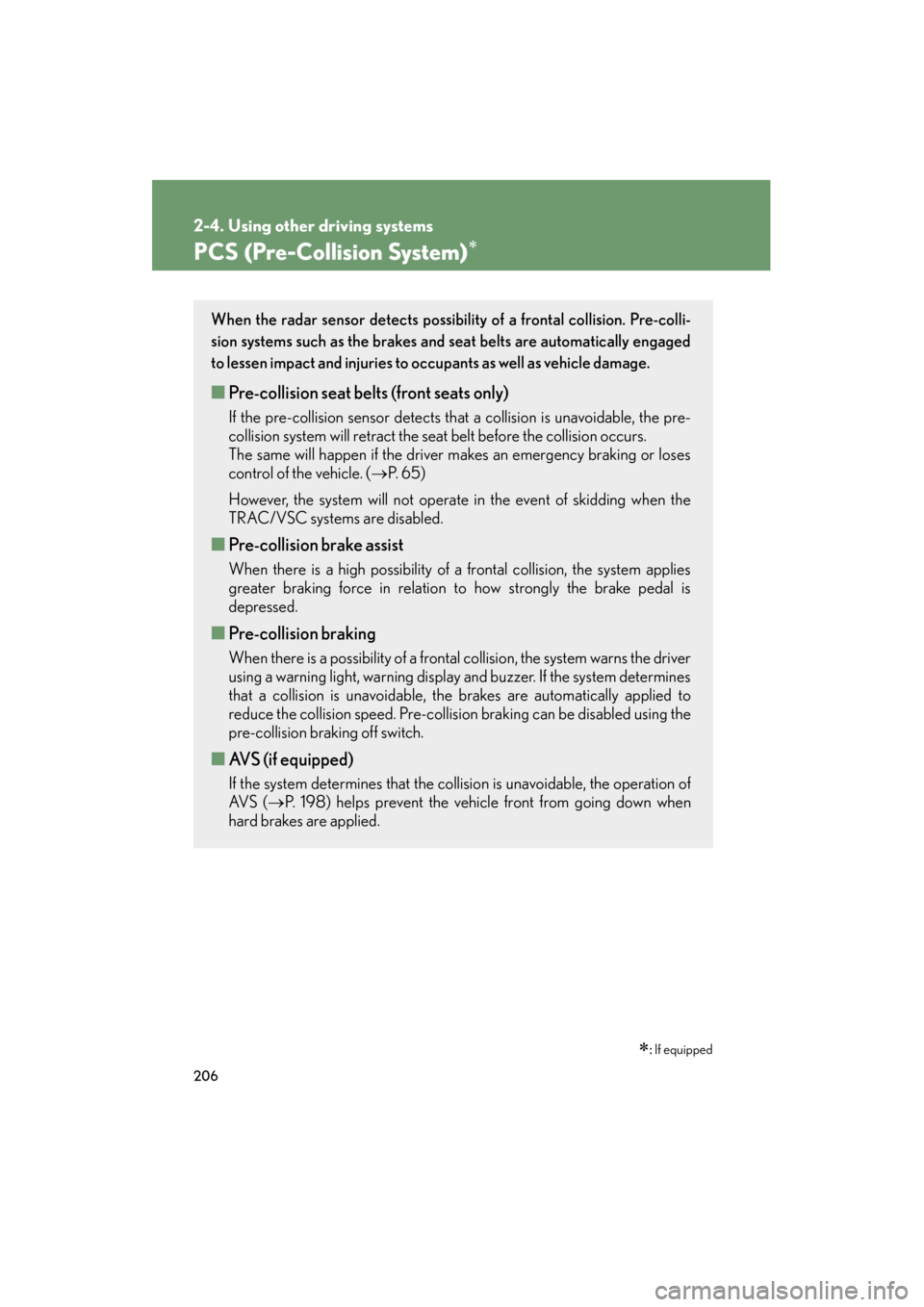
206
2-4. Using other driving systems
GS_G_U (OM30C11U)
October 28, 2011 5:15 pm
PCS (Pre-Collision System)∗
∗: If equipped
When the radar sensor detects possibility of a frontal collision. Pre-colli-
sion systems such as the brakes and seat belts are automatically engaged
to lessen impact and injuries to occupants as well as vehicle damage.
■ Pre-collision seat belts (front seats only)
If the pre-collision sensor detects that a collision is unavoidable, the pre-
collision system will retract the seat belt before the collision occurs.
The same will happen if the driver makes an emergency braking or loses
control of the vehicle. ( →P. 6 5 )
However, the system will not operate in the event of skidding when the
TRAC/VSC systems are disabled.
■ Pre-collision brake assist
When there is a high possibility of a frontal collision, the system applies
greater braking force in relation to how strongly the brake pedal is
depressed.
■Pre-collision braking
When there is a possibility of a frontal collision, the system warns the driver
using a warning light, warning display and buzzer. If the system determines
that a collision is unavoidable, the brakes are automatically applied to
reduce the collision speed. Pre-collision braking can be disabled using the
pre-collision braking off switch.
■AVS (if equipped)
If the system determines that the collision is unavoidable, the operation of
AV S ( →P. 198) helps prevent the vehicle front from going down when
hard brakes are applied.
Page 210 of 654
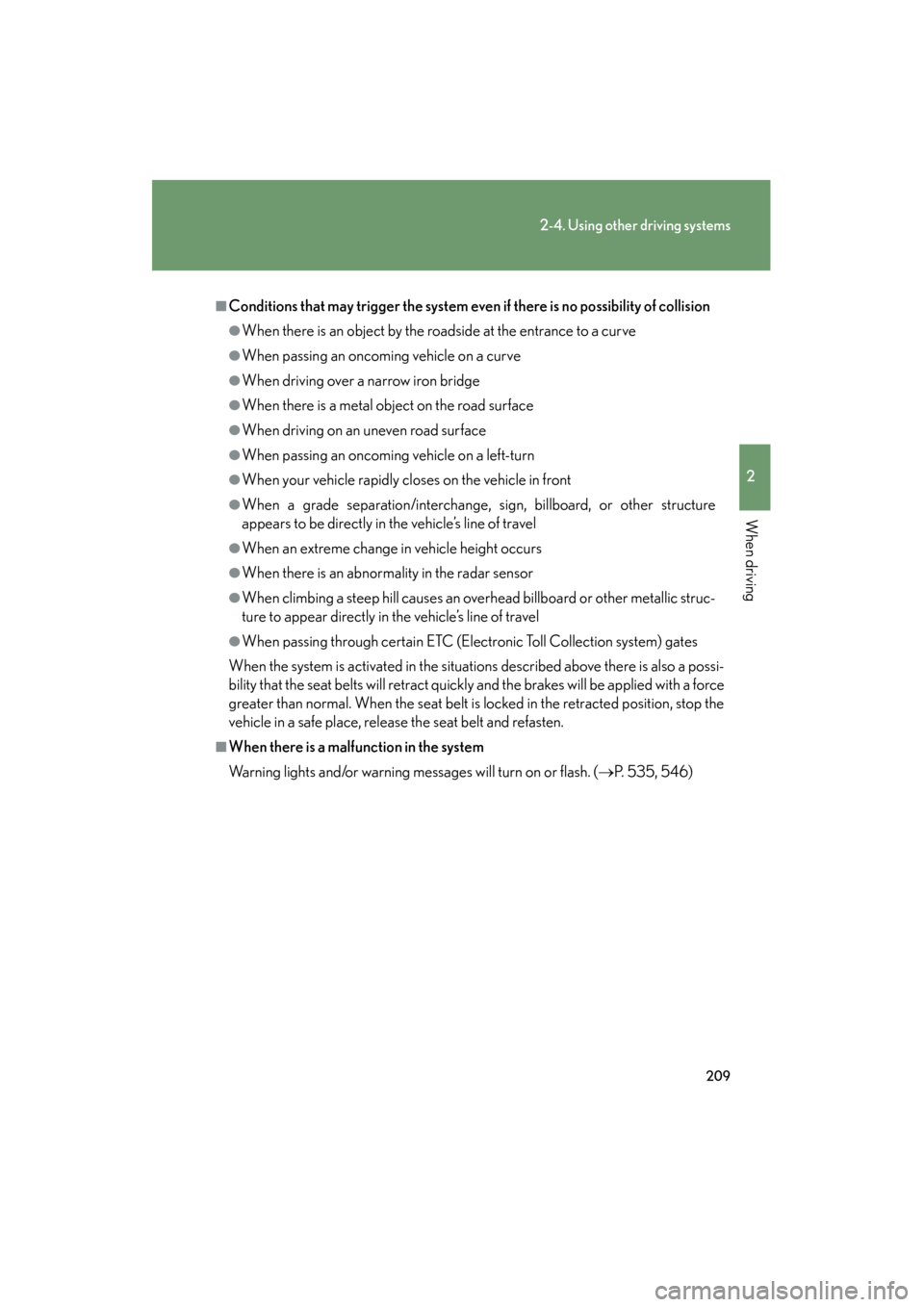
209
2-4. Using other driving systems
2
When driving
GS_G_U (OM30C11U)
October 28, 2011 5:15 pm
■Conditions that may trigger the system even if there is no possibility of collision
●When there is an object by the roadside at the entrance to a curve
●When passing an oncoming vehicle on a curve
●When driving over a narrow iron bridge
●When there is a metal object on the road surface
●When driving on an uneven road surface
●When passing an oncoming vehicle on a left-turn
●When your vehicle rapidly closes on the vehicle in front
●When a grade separation/interchange, sign, billboard, or other structure
appears to be directly in the vehicle’s line of travel
●When an extreme change in vehicle height occurs
●When there is an abnormality in the radar sensor
●When climbing a steep hill causes an overhead billboard or other metallic struc-
ture to appear directly in the vehicle’s line of travel
●When passing through certain ETC (Electronic Toll Collection system) gates
When the system is activated in the situations described above there is also a possi-
bility that the seat belts will retract quickly and the brakes will be applied with a force
greater than normal. When the seat belt is locked in the retracted position, stop the
vehicle in a safe place, release the seat belt and refasten.
■When there is a malfunction in the system
Warning lights and/or warning messages will turn on or flash. ( →P. 535, 546)
Page 219 of 654
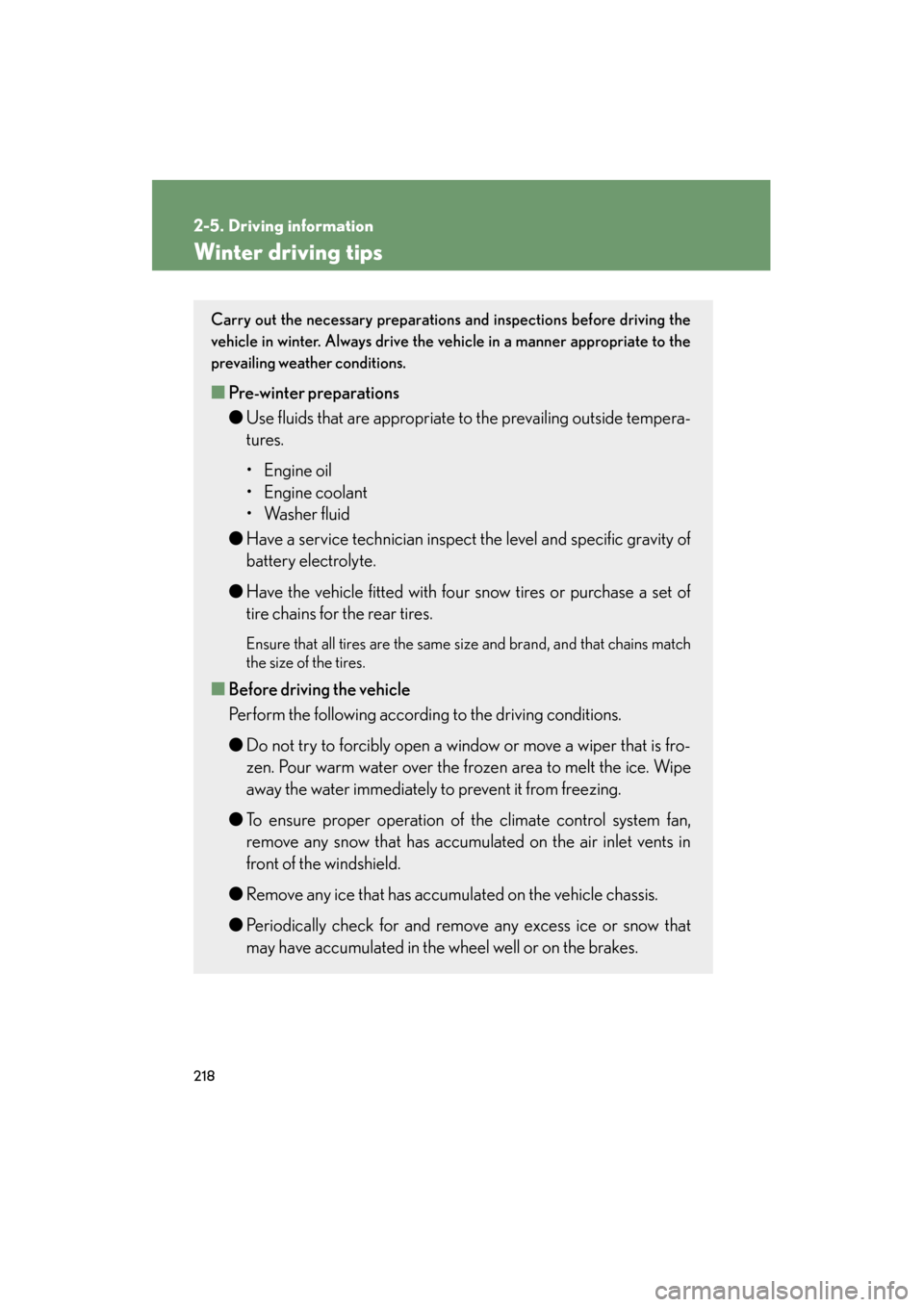
218
2-5. Driving information
GS_G_U (OM30C11U)
October 28, 2011 5:15 pm
Winter driving tips
Carry out the necessary preparations and inspections before driving the
vehicle in winter. Always drive the vehicle in a manner appropriate to the
prevailing weather conditions.
■Pre-winter preparations
●Use fluids that are appropriate to the prevailing outside tempera-
tures.
• Engine oil
• Engine coolant
• Washer fluid
● Have a service technician inspect the level and specific gravity of
battery electrolyte.
● Have the vehicle fitted with four snow tires or purchase a set of
tire chains for the rear tires.
Ensure that all tires are the same size and brand, and that chains match
the size of the tires.
■ Before driving the vehicle
Perform the following according to the driving conditions.
●Do not try to forcibly open a window or move a wiper that is fro-
zen. Pour warm water over the frozen area to melt the ice. Wipe
away the water immediately to prevent it from freezing.
● To ensure proper operation of the climate control system fan,
remove any snow that has accumulated on the air inlet vents in
front of the windshield.
● Remove any ice that has accumulated on the vehicle chassis.
● Periodically check for and remove any excess ice or snow that
may have accumulated in the wheel well or on the brakes.
Page 440 of 654
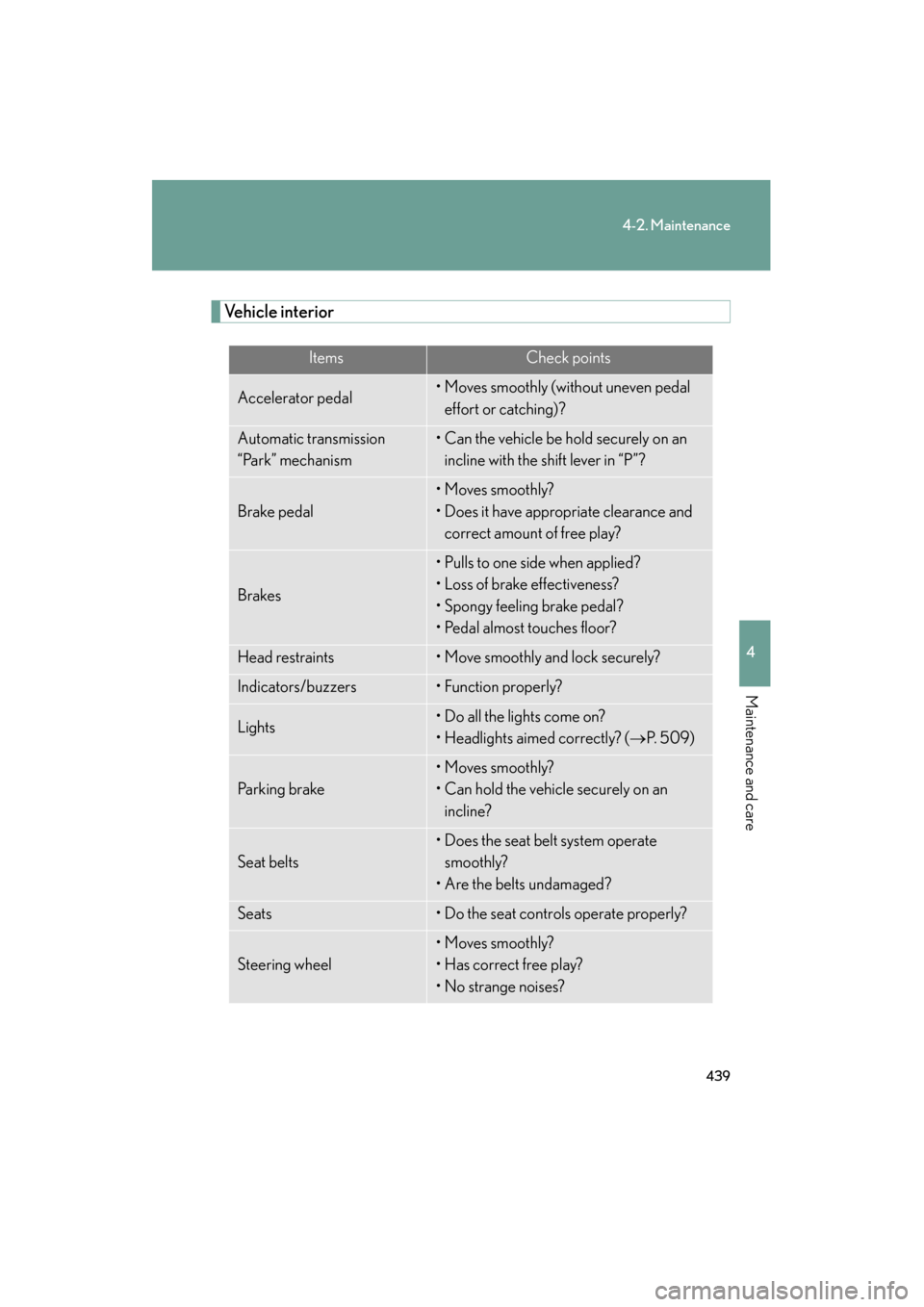
439
4-2. Maintenance
4
Maintenance and care
GS_G_U (OM30C11U)
October 28, 2011 5:15 pm
Vehicle interior
ItemsCheck points
Accelerator pedal• Moves smoothly (without uneven pedal effort or catching)?
Automatic transmission
“Park” mechanism• Can the vehicle be hold securely on an incline with the shift lever in “P”?
Brake pedal
• Moves smoothly?
• Does it have appropriate clearance and correct amount of free play?
Brakes
• Pulls to one side when applied?
• Loss of brake effectiveness?
• Spongy feeling brake pedal?
• Pedal almost touches floor?
Head restraints• Move smoothly and lock securely?
Indicators/buzzers• Function properly?
Lights• Do all the lights come on?
• Headlights aimed correctly? ( →P. 5 0 9 )
Pa r k i n g b r a ke
• Moves smoothly?
• Can hold the vehicle securely on an
incline?
Seat belts
• Does the seat belt system operate smoothly?
• Are the belts undamaged?
Seats• Do the seat controls operate properly?
Steering wheel
• Moves smoothly?
• Has correct free play?
• No strange noises?
Page 523 of 654
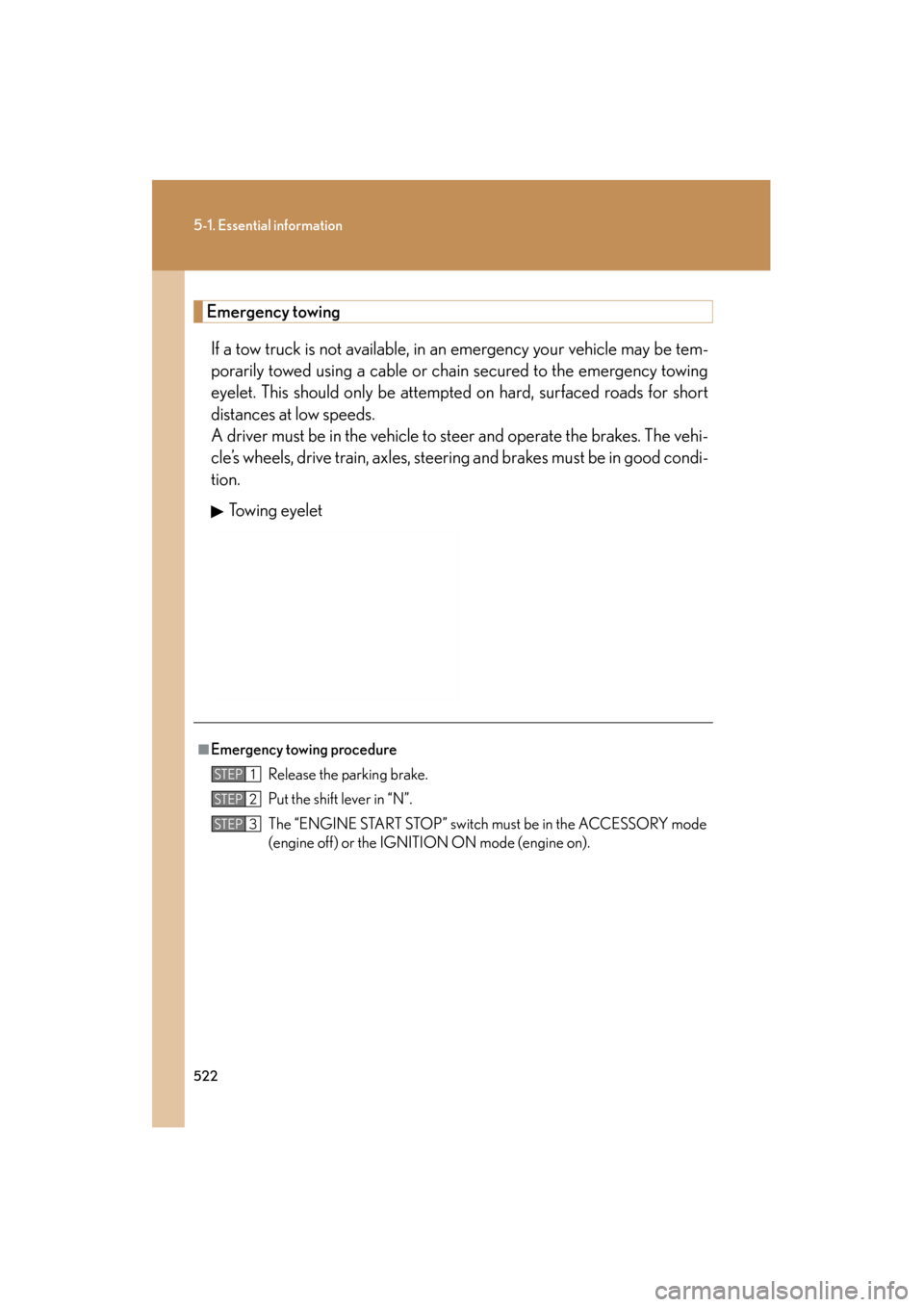
522
5-1. Essential information
GS_G_U (OM30C11U)
October 28, 2011 5:15 pm
Emergency towingIf a tow truck is not available, in an emergency your vehicle may be tem-
porarily towed using a cable or chain secured to the emergency towing
eyelet. This should only be attempted on hard, surfaced roads for short
distances at low speeds.
A driver must be in the vehicle to steer and operate the brakes. The vehi-
cle’s wheels, drive train, axles, steer ing and brakes must be in good condi-
tion.
Towing eyelet
■Emergency towing procedure Release the parking brake.
Put the shift lever in “N”.
The “ENGINE START STOP” switch must be in the ACCESSORY mode
(engine off) or the IGNITION ON mode (engine on).
STEP1
STEP2
STEP3
Page 524 of 654
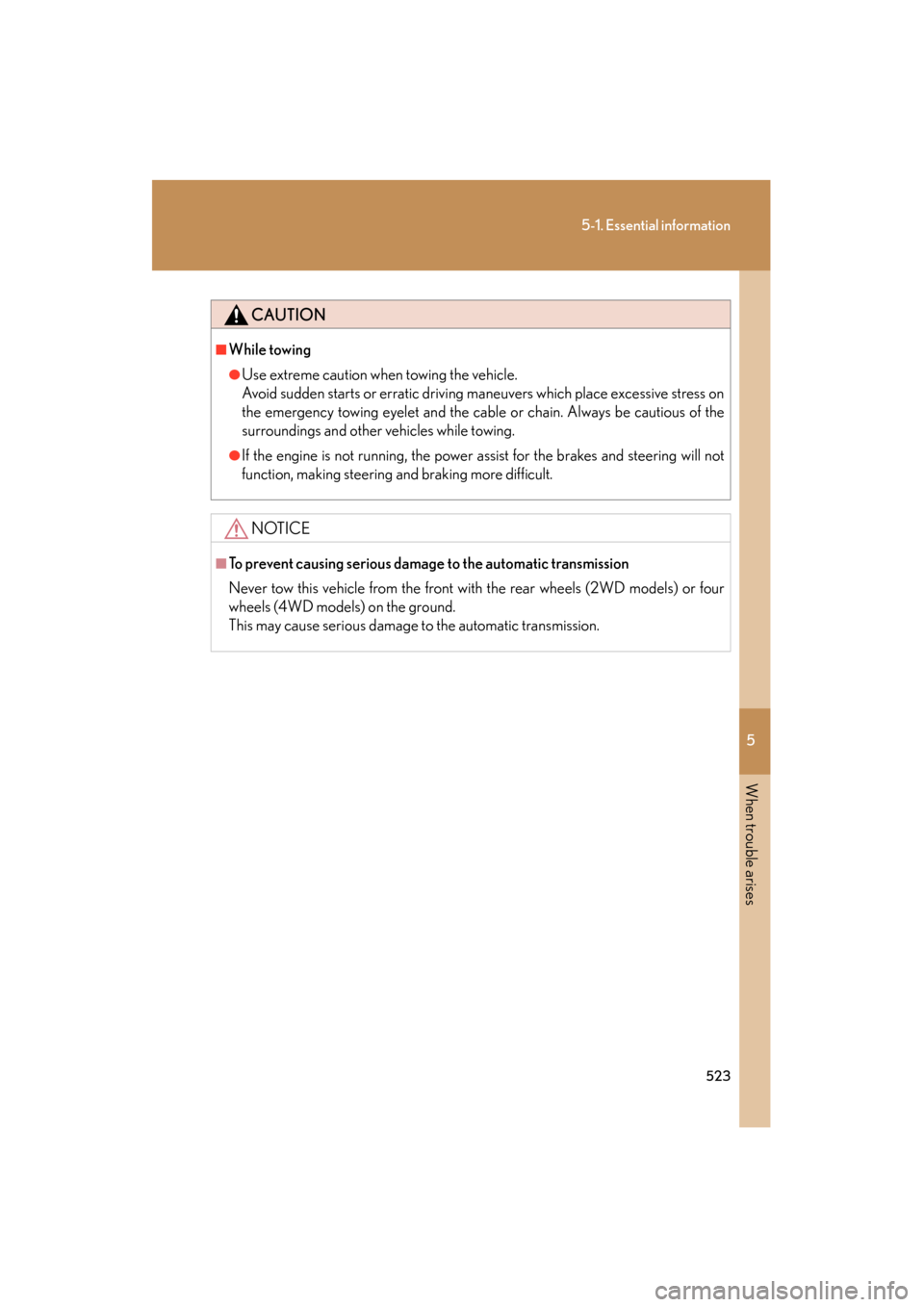
5
When trouble arises
523
5-1. Essential information
GS_G_U (OM30C11U)
October 28, 2011 5:15 pm
CAUTION
■While towing
●Use extreme caution when towing the vehicle.
Avoid sudden starts or erratic driving maneuvers which place excessive stress on
the emergency towing eyelet and the cable or chain. Always be cautious of the
surroundings and other vehicles while towing.
●If the engine is not running, the power assist for the brakes and steering will not
function, making steering and braking more difficult.
NOTICE
■To prevent causing serious damage to the automatic transmission
Never tow this vehicle from the front with the rear wheels (2WD models) or four
wheels (4WD models) on the ground.
This may cause serious damage to the automatic transmission.
Page 542 of 654
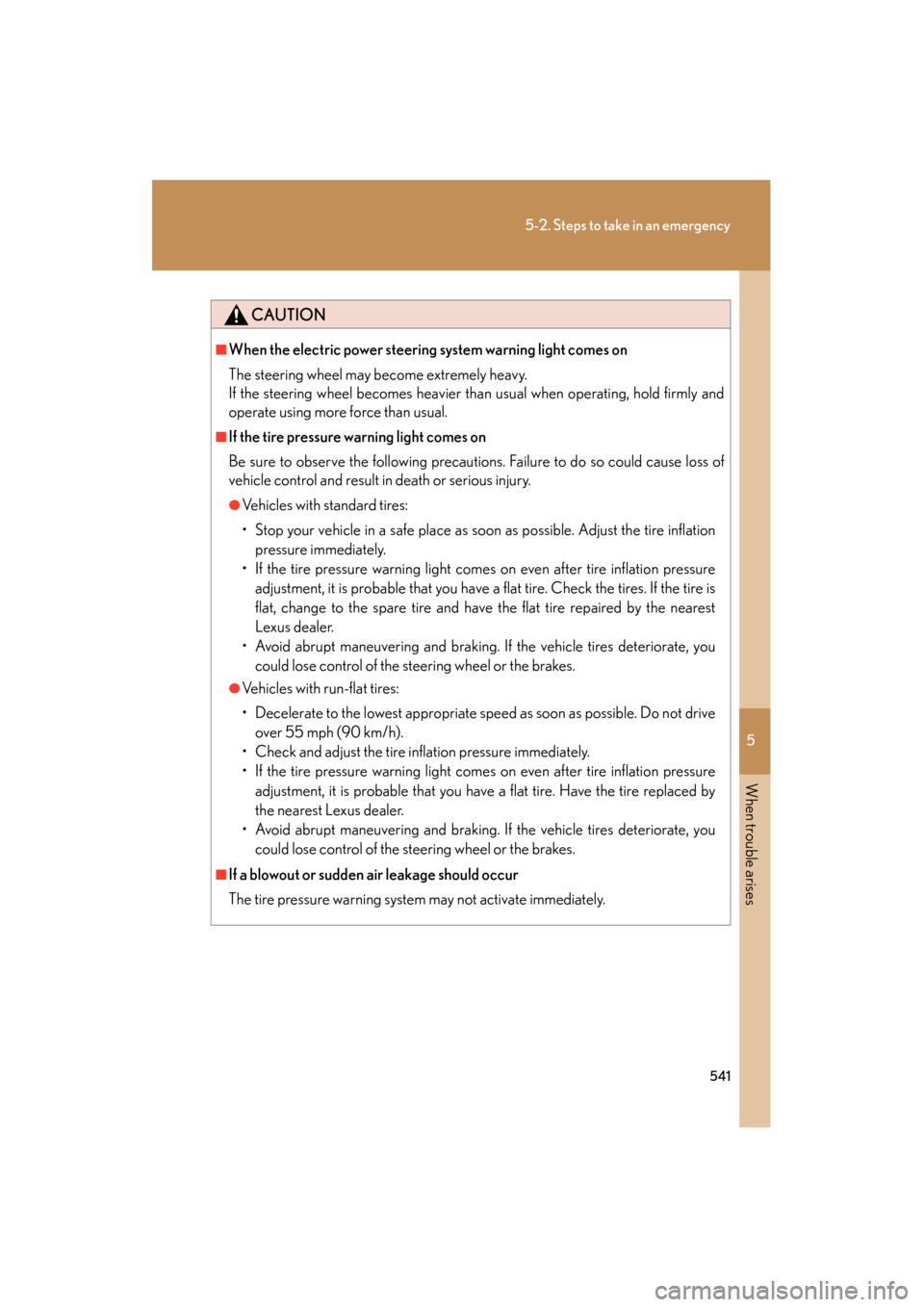
5
When trouble arises
541
5-2. Steps to take in an emergency
GS_G_U (OM30C11U)
October 28, 2011 5:15 pm
CAUTION
■When the electric power steering system warning light comes on
The steering wheel may become extremely heavy.
If the steering wheel becomes heavier than usual when operating, hold firmly and
operate using more force than usual.
■If the tire pressure warning light comes on
Be sure to observe the following precautions. Failure to do so could cause loss of
vehicle control and result in death or serious injury.
●Vehicles with standard tires:
• Stop your vehicle in a safe place as soon as possible. Adjust the tire inflationpressure immediately.
• If the tire pressure warning light comes on even after tire inflation pressure adjustment, it is probable that you have a flat tire. Check the tires. If the tire is
flat, change to the spare tire and have the flat tire repaired by the nearest
Lexus dealer.
• Avoid abrupt maneuvering and braking. If the vehicle tires deteriorate, you could lose control of the steering wheel or the brakes.
●Vehicles with run-flat tires:
• Decelerate to the lowest appropriate speed as soon as possible. Do not driveover 55 mph (90 km/h).
• Check and adjust the tire inflation pressure immediately.
• If the tire pressure warning light comes on even after tire inflation pressure
adjustment, it is probable that you have a flat tire. Have the tire replaced by
the nearest Lexus dealer.
• Avoid abrupt maneuvering and braking. If the vehicle tires deteriorate, you could lose control of the steering wheel or the brakes.
■If a blowout or sudden air leakage should occur
The tire pressure warning system may not activate immediately.
Page 553 of 654
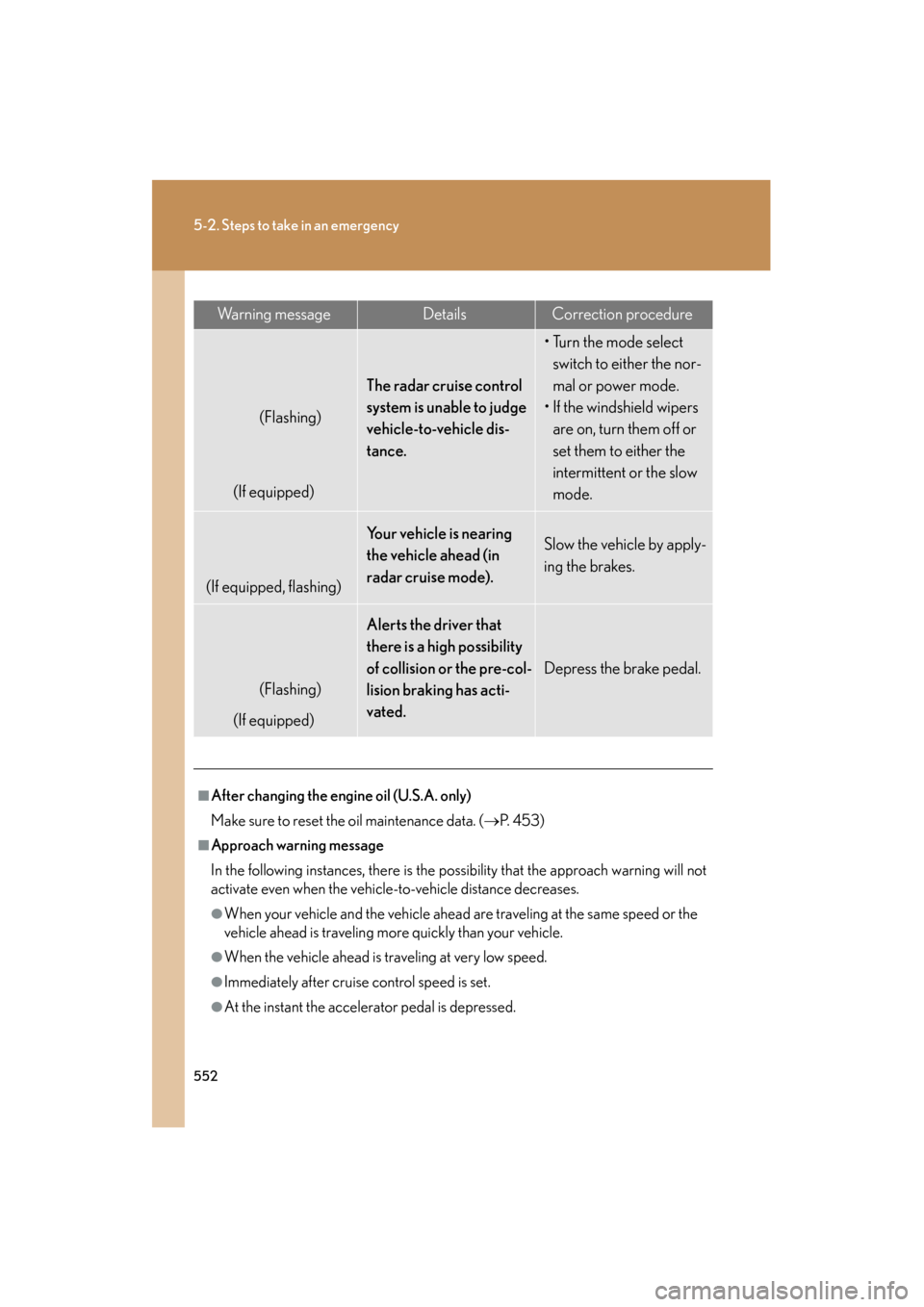
552
5-2. Steps to take in an emergency
GS_G_U (OM30C11U)
October 28, 2011 5:15 pm
Wa r n i n g m e s s a g eDetailsCorrection procedure
(Flashing)
(If equipped)
The radar cruise control
system is unable to judge
vehicle-to-vehicle dis-
tance.
•Turn the mode select switch to either the nor-
mal or power mode.
• If the windshield wipers are on, turn them off or
set them to either the
intermittent or the slow
mode.
(If equipped, flashing)
Your vehicle is nearing
the vehicle ahead (in
radar cruise mode).Slow the vehicle by apply-
ing the brakes.
(Flashing)
(If equipped)
Alerts the driver that
there is a high possibility
of collision or the pre-col-
lision braking has acti-
vated.
Depress the brake pedal.
■After changing the engine oil (U.S.A. only)
Make sure to reset the oil maintenance data. ( →P. 4 5 3 )
■Approach warning message
In the following instances, there is the possibility that the approach warning will not
activate even when the vehicle-to-vehicle distance decreases.
●When your vehicle and the vehicle ahead are traveling at the same speed or the
vehicle ahead is traveling more quickly than your vehicle.
●When the vehicle ahead is traveling at very low speed.
●Immediately after cruise control speed is set.
●At the instant the accelerator pedal is depressed.
Page 557 of 654

556
5-2. Steps to take in an emergency
GS_G_U (OM30C11U)
October 28, 2011 5:15 pm
InteriorbuzzerExterior buzzerWarning messageDetailsCorrection procedure
An open door has
been closed and
the “ENGINE
START STOP”
switch has been
turned twice to
the ACCES-
SORY mode from
OFF.
Press the
“ENGINE
START
STOP”
switch while
applying the
brakes.
(Flashing)
The steering lock
has not released
within 3 seconds
of pressing the
“ENGINE START
STOP” switch.
The “ENGINE
START STOP”
switch indicator
will flash green for
15 seconds.Press the
“ENGINE
START
STOP”
switch again
while turn-
ing the
steering
wheel with
the brake
pedal
depressed.
Once
(Comes on for 60 seconds)The electronic key
does not operate
properly.
→ P. 5 7 1
(Comes on for 10 seconds)
Page 573 of 654

572
5-2. Steps to take in an emergency
GS_G_U (OM30C11U)
October 28, 2011 5:15 pm
Tr u n kTurn the mechanical key clock-
wise to open.
Changing “ENGINE START STOP” sw itch modes and starting the
engine
Put the shift lever in “P” and apply the brakes. Touch the Lexus emblem side of
the electronic key to the
“ENGINE START STOP” switch.
An alarm will sound to indicate that
the start function cannot detect the
electronic key that is touched to
the “ENGINE START STOP”
switch if any of the doors is opened
and closed while the key is touched
to the switch.
To change the “ENGINE START STOP” switch modes: Within 10
seconds of the buzzer sounding, release the brake pedal and
press the “ENGINE START STOP” switch. Modes can be
changed each time the switch is pressed. (
→P. 1 3 4 )
To start the engine: Press the “ENGINE START STOP” switch
within 10 seconds after the buzzer sounds, keeping the brake
pedal depressed.
If the “ENGINE START STOP” switch still cannot be operated, contact
your Lexus dealer.
STEP1
STEP2
STEP3